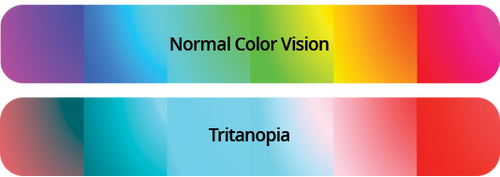Tritan Color Blindness
Tritan Color Blindness / Tritanomaly
Tritan Color Blindness (“try-tan”) includes tritanomaly and tritanopia. It is also sometimes called blue-yellow color blindness. Tritan color blindness most commonly acquired later in life due to aging of the eye or a medical condition such as glaucoma and is only very rarely inherited from birth. Tritan color vision is generally characterized by a reduced sensitivity in the blue-sensitive “S” cone cells. “S” stands for Short Wavelength Light. The retinal S-cone cells make up only about 1% of the approximately 6 million retinal cone cells, so when they are damaged or not functioning properly, it can easily cause a degradation to color vision. Typically a person with a tritan-type color vision deficiency does not see blue colors well, and may have difficulty seeing the difference between blue and green. Cataracts, glaucoma, and age-related macular degeneration can cause symptoms of tritan color blindness. Another factor that causes reduced sensitivity to blue is the yellowing of the crystalline lens within the eye: these cells do not regenerate and over a lifetime of exposure to light, especially UV light, the lens tends to become yellow in appearance and block the transmission of blue light, interfering with color vision. Eventually this yellowing also leads to cataracts that must be treated surgically.

EnChroma Glasses and Blue-Yellow Color Blindness
EnChroma glasses are unlikely to help for tritanomaly or tritanopia (blue-yellow color blindness) as the glasses are mainly effective for red-green color blindness. If you believe you have tritanomaly, we recommend you consult with an eye care professional for a complete vision assessment.
Tritan Color Blindness
Tritan Color Blindness / Tritanomaly
Tritan Color Blindness (“try-tan”) includes tritanomaly and tritanopia. It is also sometimes called blue-yellow color blindness. Tritan color blindness most commonly acquired later in life due to aging of the eye or a medical condition such as glaucoma and is only very rarely inherited from birth. Tritan color vision is generally characterized by a reduced sensitivity in the blue-sensitive “S” cone cells. “S” stands for Short Wavelength Light. The retinal S-cone cells make up only about 1% of the approximately 6 million retinal cone cells, so when they are damaged or not functioning properly, it can easily cause a degradation to color vision. Typically a person with a tritan-type color vision deficiency does not see blue colors well, and may have difficulty seeing the difference between blue and green. Cataracts, glaucoma, and age-related macular degeneration can cause symptoms of tritan color blindness. Another factor that causes reduced sensitivity to blue is the yellowing of the crystalline lens within the eye: these cells do not regenerate and over a lifetime of exposure to light, especially UV light, the lens tends to become yellow in appearance and block the transmission of blue light, interfering with color vision. Eventually this yellowing also leads to cataracts that must be treated surgically.

EnChroma Glasses and Blue-Yellow Color Blindness
EnChroma glasses are unlikely to help for tritanomaly or tritanopia (blue-yellow color blindness) as the glasses are mainly effective for red-green color blindness. If you believe you have tritanomaly, we recommend you consult with an eye care professional for a complete vision assessment.

